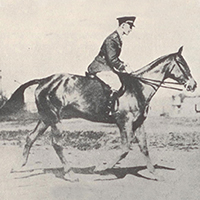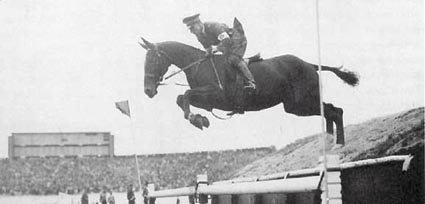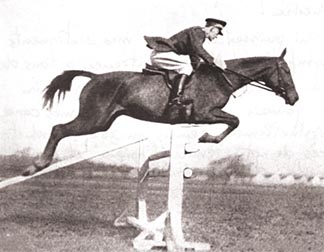Who's Who

Chamberlin, Harry D
Born : 1887
Died : 1944

Brig. Gen H.D. Chamberlin studied at the French (Samur) and Italian (Tor di Quinto) cavalry academies in the 1920’s. He brought modern Italian and French concepts home to the U.S. Army Equestrian Team in the 1930’s and early 1940’s. Chamberlin’s method was generally based on the Italian school of Caprilli. His books, which included the Fort Riley Cavalry Manual, set forth these ideas very clearly. Fort Riley pupils (enlisted men and officers) had an enormous influence on American riding from at least the 1930’s through the 1970’s. Chamberlin’s most famous book, Training Hunters Jumpers and Hacks, was first published in 1937.
The Russian riding master Vladimir S. Littauer who settled in the United States, and wrote the neglected masterpiece, Horseman’s Progress in 1961, has this to say about Chamberlin:
“Col. Chamberlin studied both at Saumur and at Tor di Quinto; he was at the latter school in 1923. In the prefaces to his books he modestly says that ‘for the Seat advocated, the writer is principally indebted to the Italian Cavalry School’, while the ‘credit for the system of training enunciated herein is due to the French Cavalry School.’ He modified both seat and schooling, however, and his second book in particular represents neither the French nor the Italian school in its purity, but is his sound, original contribution to the cause of educated riding.”

“Those ideas of Chamberlin which resulted from his studies in Italy were the ones which were most influential in helping me to form my own techniques, since some of the Italian reasoning was still new to me, while I was already familiar with the French school of manege riding. The following quotations, which represent fundamental points of the new type of riding, are taken from different parts of the book:
“At the walk… the strides, when studied from the side should be long, free and close to the ground… the hind leg moves freely with little perceptible flexion at the hock…”
“The trot, though springy, should be low, with feet moving close to the ground as a result of minimum flexion of knees and hocks.”
“A good galloper’s feet travel close to the ground with little knee and hock action…”
“These key phrases clearly indicate that collected gaits were not a part of the Chamberlin method.
“Jumping and cross-country work over varied terrain both on a loose rein and with the normal contact, improve balance and agility…”
Loose-rein work, particularly at the beginning of schooling has since become a very important and successful part of my teaching.
“Balance can be immeasurably improved by special gymnastic exercises. However the artificial form of collection acquired though highh-schooling is not suitable to improving the balance of these horses (hunters and jumps). In high-school collection the hocks are flexed, the croup lowered, the neck raise and the face brought in to an almost vertical plane… such horses… are unable to handle themselves cleverly when given their heads and left to their own devices and so are practically worthless for cross-country work.”
“Absurd as it may seem today, this paragraph made me ponder a long time. I knew that the advanced forms of High School collection should not be used in field riding, but I had been brought up on the idea that a lower degree of collection should be a part of the training of every horse, no matter what his job. It was rather difficult to abandon this notion, which had been drilled into me, and to replace it with the conception of what Chamberlin calls ‘natural collection’, that is the ability of the horse to gather himself for a few seconds here and there when a sudden change in terrain, an abrupt slowing down of the gait, or an abrupt halt calls for it. There is a tremendous difference between the horse gathering himself under these circumstances or moving forward at collected gaits.”
“By the term ‘natural collection’,” which Chamberlin unfortunately never precisely defined, he also obviously meant that at gaits the horse should be united; today, I often use the term a “connected horse.”
But to resume quoting Chamberlin:
“Keeping the horse’s head turned inward while working on the circle is occasionally beneficial as a gymnastic and disciplinary exercise but should not be insisted on normally… It is unnatural, impedes the inside shoulder, shortens the stride and instigates resistance…”
“The pernicious custom, frequently seen in high-schooling and elsewhere, of striving to hold the horse’s body on an absolutely straight line while at the gallop, and the even more ruinous one of habitually bending the spine and neck outwards to conform to the curve being travelled, shorten the stride, cramp and annoy the horse. These faulty methods are to be carefully shunned in the practical training of outdoor horses…”
I must confess that it was hard for me to relinquish the belief once taught me that the horse should be bent to correspond to the curve of the line along which he moves. I had preserved this tenet of dressage longer than any other. Evidently it is equally hard for many other horsemen to abandon this idea, and even today some of them, by requiring small circles, induce that bending of the horsewhich according to Chamberlin is a ‘ruinous’ procedure.
“Cantering false- i.e . leading with the left leg when curving or circling to the right, or vice versa-lengthens and lowers the stride; supples the spine; lowers the head and neck; puts the horse on the bit; and improves balance and agility.”
This exercise eventually became one of the very fundamental ones of my method. I teach it to a green horse when he still does not know the leads and is too awkward to make changes by himself. Consequently, in the early stages of schooling in a ring, I never insist on the inside lead; this results in a certain amount of accidental cantering on the wrong lead and thus the false canter develops by itself, and brings with it all the benefits enumerated by Chamberlin.
If you compare these fundamental principles of Chamberlin with those of Caprilli you will find that they have a great deal in common. Much of what Caprilli taught and Krassnoff described, Chamberlin wrote. The same belief in free gaits, in absence of real collection, in not bending the horse in the sides and neck when making a turn, in disregarding the lead (that is, cantering false) and in riding either on loose reins or on soft contact, is there. If I were not afraid of being tiresome I could make a still longer list of Italian elements in Chamberlin’s teaching. On second thought, I would like to include here one more of his paragraphs, about flexions of the mouth and the poll. You will remember that these flexions always were predominantly important in dressage schooling and were taught dismounted, in hand. On this subject Chamberlin wrote:
“Suppling of the jaw while dismounted, still practiced by some high-school experts, is entirely unnecessary for the average riding horse. These flexions were perhaps essential when few horsemen owned Thoroughbred horses, or those close to the blood. For the most part, saddle horses of those days were coarse, thick-necked, and poorly bred. Moreover, they were continuously held to slow gaits suitable to the airs of the high school, for there were no equestrian sports requiring great speed. The slow, collected gaits, and training of former times are unsuitable for modern riding.”
Not surprisingly, nearly all Chamberlin’s ideas on jumping proper are of Italian origin. Thus his fundamental principle is non-interference with the horse’s own calculation of the take-off:
“The main and most difficult task of the trainer when riding over an obstacle is to ‘let the horse alone.’ Simple though this sounds, in practice it requires cool nerve and great coordination…”
“The idea that one can ‘place’ his horse for each jump over a course of big and imposing obstacles is erroneous. Many really brilliant riders have tried it, but without complete success. The horse must do the jumping, and the less he is bothered, except to encourage and rate him, the better he will do…”
